On a recent sunny day in Oslo, Jay and Tanya went searching for what defines the Norwegian character. What is it that makes Norwegians, and their descendants, think and act the way they do? Essentially, what is “Norwegianness”? Tanya has often observed that Jay’s Norwegian background definitely influences his behavior—“If there’s an easy way and a hard way of doing something, Jay will do it the hard way.” And, of course, that’s true. After all, if you don’t suffer in the process of achieving something, then what’s the point? Where’s the joy in the victory?
We didn’t have far to go to find two excellent examples of the Norwegian way of looking at life. First, it was a trip to the Vikingskipshuset, the Viking Ship Museum.  Housed in a nondescript white building that looks like it was a church at one time, are the remains of and artifacts taken from three Viking sailing ships, two of which are the best preserved in the world. These ships were unearthed between 1850 and 1904. All had been previously at sea but were used as burial chambers for high-ranking Vikings. Before being buried, the ships were filled, not only with the deceased Viking corpse, but with jewelry, clothing, furniture, tools, servants, cows and horses to be used in the afterlife.
Housed in a nondescript white building that looks like it was a church at one time, are the remains of and artifacts taken from three Viking sailing ships, two of which are the best preserved in the world. These ships were unearthed between 1850 and 1904. All had been previously at sea but were used as burial chambers for high-ranking Vikings. Before being buried, the ships were filled, not only with the deceased Viking corpse, but with jewelry, clothing, furniture, tools, servants, cows and horses to be used in the afterlife.


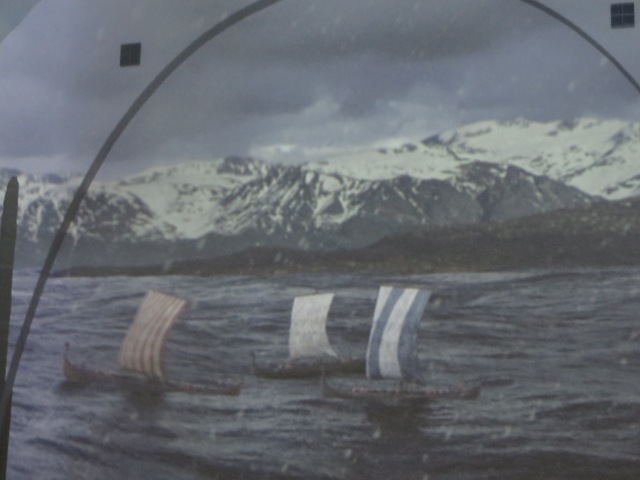
Now think about this for a minute. First, it takes a certain kind of people to build these open boats and then fill them with guys who are willing to head out to open sea in search of God knows what—treasure, slaves, and other stuff. You can just imagine some Viking chief recruiting his crew: “Hey guys! Let’s all get in this boat and go rowing! It should be fun! I know we don’t have any maps or GPS and don’t really have a very good idea of where we’re going. And, we’ll surely be cold, hot and generally miserable, and a lot of us will most certainly die, but all this suffering will be worth it, somehow. OK, grab your gear and let’s go! What do you say?”
And, these guys actually went. And, they went a long ways. The Vikings sailed to Iceland, North America, the British Isles, and Spain. They sailed into the Mediterranean, the Black Sea and generally all over Europe and into the Middle East. This was hundreds of years before the Portuguese and Spanish in the “Age of Exploration”. And all in these little boats. Some may call the Vikings nothing more than a bunch of marauding, pillaging barbarians, but you’ve got to admit they were some pretty tough people. This was hard. They suffered. So Norwegian.
But when the voyages of some of the Viking chiefs ended, the hard work and suffering didn’t end there. We mentioned earlier how the three Viking ships in the museum were discovered—buried along with everything the chiefs would need in the afterlife. It was not enough to just bury the chief after death. No, a huge hole had to be dug, big enough for the entire ship and all the stuff to go with it. The ship had to be dragged up from the water and into a field. A protective wooden covering shielded the goods during the burial and then the whole ship, along with livestock and servants was covered over, leaving a huge earthen mound to mark the spot. So, not only were the Viking chiefs persuasive enough to recruit crews for their incredible voyages, somebody had to persuade these servants to “take one for the Gipper” and get buried along with their boss. Now that’s suffering.
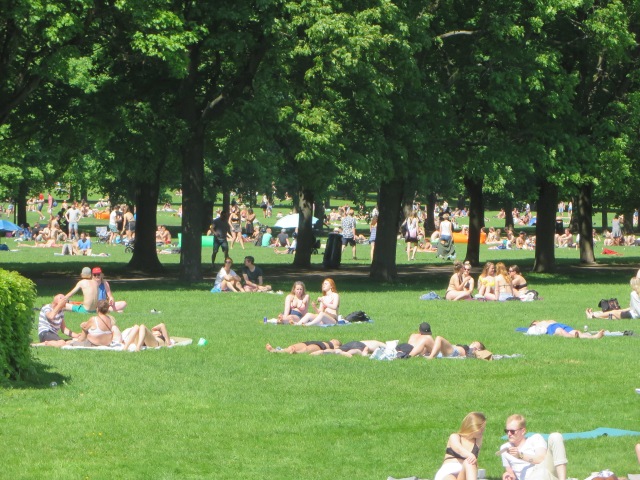
 We then went on to the second example of the Norwegian mindset: Vigeland Park. This park is part of the larger Frognerpark, slightly northwest of city center Oslo. The park features large grassy expanses, and on this sunny Saturday afternoon, was filled with people enjoying picnics and soaking up the sun. Not exactly an example of suffering, except given the fair Norwegian skin there would no doubt some sunburn suffering the following day.
We then went on to the second example of the Norwegian mindset: Vigeland Park. This park is part of the larger Frognerpark, slightly northwest of city center Oslo. The park features large grassy expanses, and on this sunny Saturday afternoon, was filled with people enjoying picnics and soaking up the sun. Not exactly an example of suffering, except given the fair Norwegian skin there would no doubt some sunburn suffering the following day.
The highlight of the park however is the sculpture garden containing the works of the famous Norwegian artist, Gustav Vigeland. Vigeland was this amazing Norwegian who lived between 1869 and 1943. Besides creating the 212 bronze and granite sculptures in Frognerpark, he also is noted for designing the Nobel Peace Prize medal. His primary themes are death and the relationship between man and woman. The result is what we’ve included here.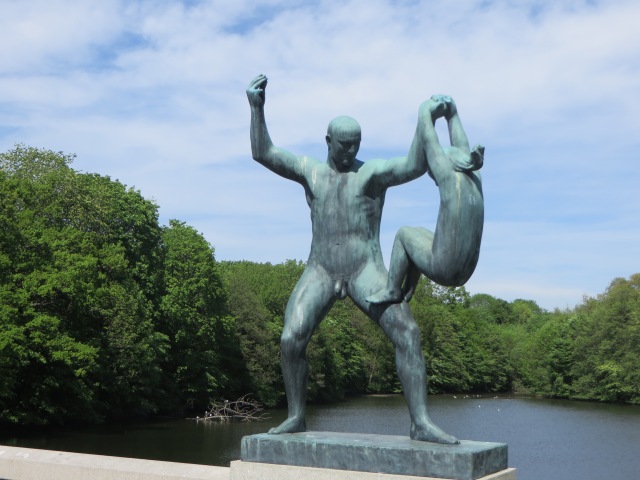

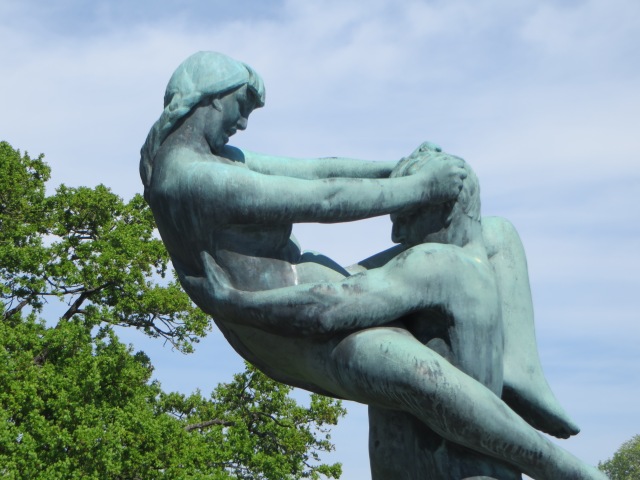
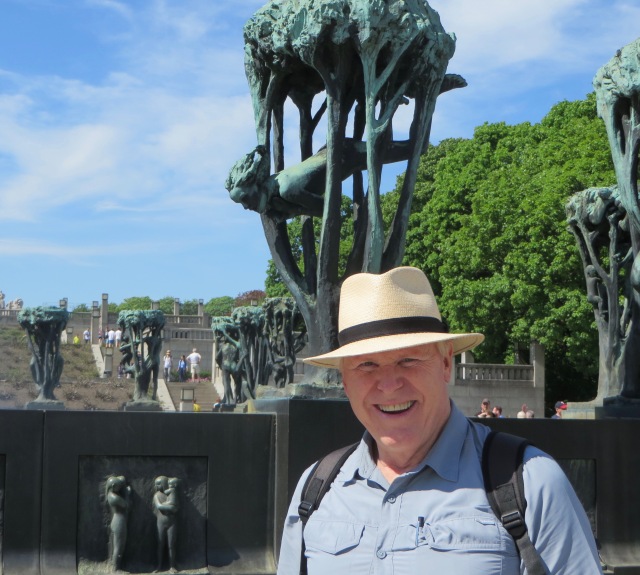





Vigeland’s work may not appeal to everyone. And, frankly, much of it is kind of disturbing, especially the famous Monolith, featuring 121 naked human figures struggling to reach to top.  But, Jay sees Vigeland’s work as an appropriate manifestation of “Norwegianness”, that is struggling and doing things the hard way. The work and messages Vigeland put into carving these figures from granite can be compared to the struggles and suffering of the Vikings. If there is no struggle and hardship, what use is the victory? This is what defines being Norwegian. It also partially explains the guilt and uneasiness many Norwegians feel about the wealth of recent decades as a result of North Sea oil drilling and how this “easy money” has affected their traditional way of life. But that could be the subject of another posting.
But, Jay sees Vigeland’s work as an appropriate manifestation of “Norwegianness”, that is struggling and doing things the hard way. The work and messages Vigeland put into carving these figures from granite can be compared to the struggles and suffering of the Vikings. If there is no struggle and hardship, what use is the victory? This is what defines being Norwegian. It also partially explains the guilt and uneasiness many Norwegians feel about the wealth of recent decades as a result of North Sea oil drilling and how this “easy money” has affected their traditional way of life. But that could be the subject of another posting.

How interesting!! I definitely learned some things about the Vikings!! I would not want to be one!
Vigeland’s sculptures are definitely disturbing, especially the tower! But the male-female depictions are a little nightmarish as well!
Tanya certainly knows you better than I do! In real estate, I always admired your ability to see through the nonsense and not get bogged down by the big egos and over-serious approach h taken by others. So, where does that trait come from in your familial history?
LikeLike
Kathleen, I’m not sure where that trait comes from. Maybe there’s some Thai in my DNA somewhere.
LikeLike
Aloha Jay and Tanya,
Truly fascinating. I so enjoy your writing style and learning little details not learned in History classes or readings.
What a wonderful book this could make as you present it from such a personal point of view coupled with a knack for capturing things that make each place unique.
Mahalo, Lynne Berry Westlake
>
LikeLike
Thank you Lynne. Glad you enjoy it.
LikeLike